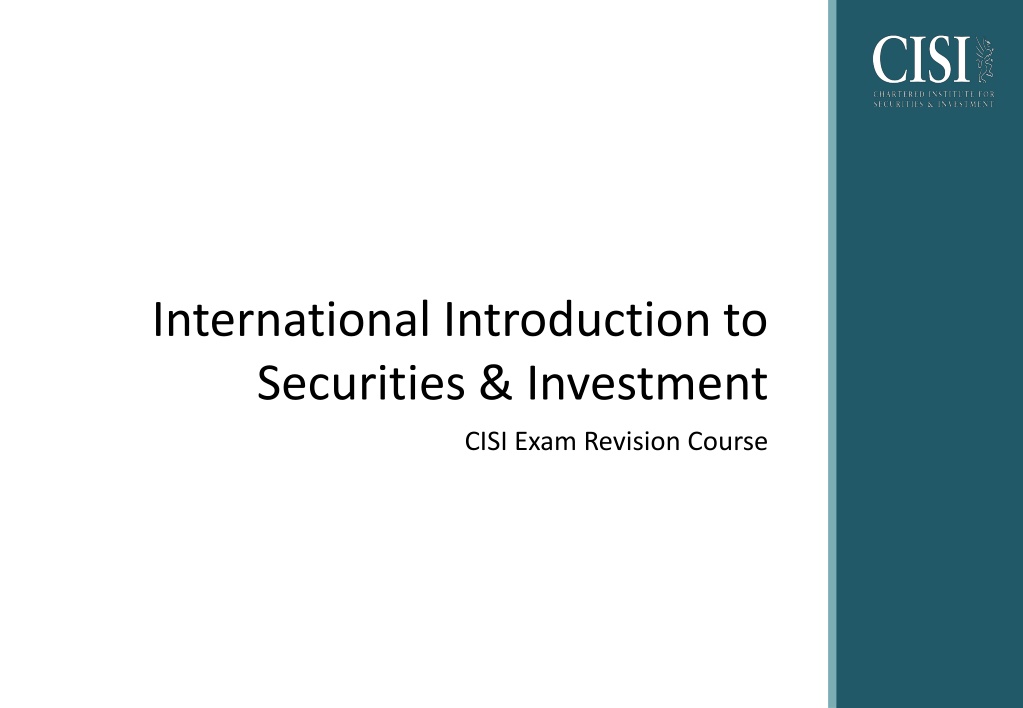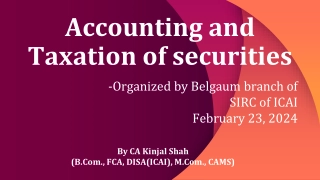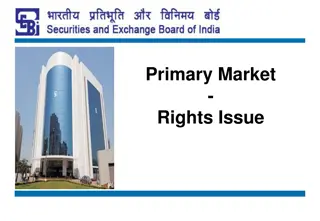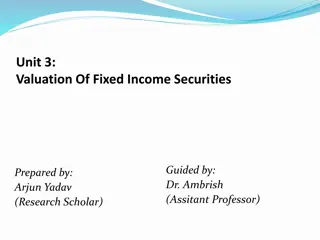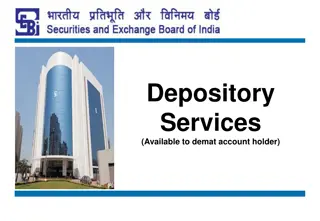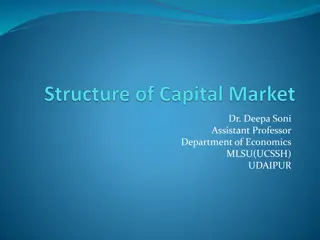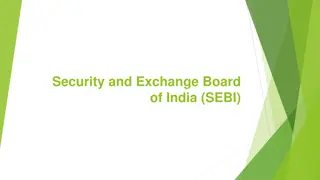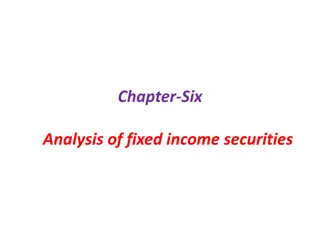Overview of CISI Exam Revision Course for Securities & Investment
Explore the CISI exam revision course for securities and investment, offered by the leading professional body for investment industry staff. Learn about the qualifications, global presence, and diverse range of exams focused on the international marketplace. Gain a valuable understanding of investment areas, economic environments, financial products, and regulatory ethics through this tailored program designed for new entrants in the industry.
Download Presentation

Please find below an Image/Link to download the presentation.
The content on the website is provided AS IS for your information and personal use only. It may not be sold, licensed, or shared on other websites without obtaining consent from the author. Download presentation by click this link. If you encounter any issues during the download, it is possible that the publisher has removed the file from their server.
E N D
Presentation Transcript
International Introduction to Securities & Investment CISI Exam Revision Course
CISI Leading professional body for staff employed in the investment industry CISI Qualifications Global presence:- Exams offered in Australia, China, India, the Middle East and Europe Foundation Level Fundamentals of Financial Services International Introduction to Securities & Investments Professional Exams Wealth Management Financial Planning Corporate Finance Investment Operations Islamic Finance Regulatory exams Main examining body for investment related exams and offers unique range of exams focused on international marketplace Post Graduate Professional Exams Chartered Wealth Manager Certified Financial Planner Diploma in Investment Compliance Diploma in Investment Operations Diploma in Corporate Finance Diploma in Capital markets Extensive CPD programme 2
Objective of the Qualification Designed to meet the needs of new entrants to the investment industry With a tailored and focused approach to international markets, the award provides an overview of all areas of investment The qualification offers staff in a wide range of roles a valuable understanding of the language of the industry and provides firms with a benchmark entry level qualification which can be used for induction purposes The Award is a stand alone benchmark examination as well as a technical unit within the Certificate in Investment Operations
Workbook Derivatives Financial Services Sector An introduction to the financial services sector and the main participants that are seen in financial centres around the globe Brief review of derivatives to provide an understanding of the key features of futures and options and the terminology associated with them Investment Funds Economic Environment Some key aspects of macro-economics, key measures of economic data and the role of central banks in management of the economy Main types including unit trusts, OEICs, Investment Trusts, Hedge Funds and Private Equity Regulation and Ethics Equities Formation of companies, how companies are listed, the benefits and risks of owning shares and the methods by which they are settled An overview of international regulation including specific areas such as financial crime and insider dealing as well as professional integrity and ethics Other Financial Products Bonds Key characteristics and types of government and corporate bonds and the risks and returns associated with them Main types of financial products, including pensions, loans, mortgages and life assurance Financial Advice Other financial assets Cash deposits, money markets, property and foreign exchange 4
Syllabus 5
Exam Questions Know . The Bank of Japan is which of the following? a) Retail Bank b) Investment Bank c) Central Bank d) Custodian Bank Understand .. What is the most likely effect of a central bank raising interest rates? a) Share prices will rise b) Share prices will fall c) Government bond prices will rise d) Corporate bond prices will rise 6
Exam Specification Chapter Subject No of Questions 1 Introduction 3 2 Economic Environment 3 3 Equities/Stocks 9 4 Bonds 7 5 Other financial assets 5 6 Derivatives 4 7 Investment Funds 6 8 Regulation and Ethics 5 9 Other Financial Products 5 10 Financial Advice 3 Total Questions 50 7
Best Practice Best practice from exam revision courses Need to work through the detail in the workbook Test knowledge against end of chapter questions Test knowledge against the Learning Objectives Identify areas where additional study needed Use mock exams for practice 8
Wholesale and Retail Firms Wholesale Markets:- Retail Markets:- Equity markets Retail banking Bond markets Insurance Foreign exchange Pensions Derivatives Investment services Insurance Financial planning and financial advice 11
Participants - Banks Investment Banks Corporate finance and advisory work Banking, for governments, institutions and companies Treasury Investment management Securities trading Custodian Banks Holding assets in safekeeping Arranging settlement of purchases and sales of securities Collecting income from assets Providing information on underlying companies Managing cash transactions Performing foreign exchange transactions Retail Banks Savings Institutions Deposit taking Lending Payment services Money transmission Specialised deposit companies Savings products Mortgage lending Typically mutual organisations 12
Participants - Others Peer-2-peer and Crowdfunding Insurance Companies Cuts out banks Higher risk for savers Higher returns Slightly lower rates for borrowers Life and general insurance Protection planning Invest premiums in equities and bonds Retirement Schemes Aimed at providing retirement income Generally defined contribution schemes Either company scheme or self-directed Shares, bonds and cash Fund Managers Invest in shares, bonds and other assets Charge percentage of value and/or performance fee 13
Participants - Others Stockbrokers Execution only services Robo-advisors Advisory and discretionary wealth managers Institutional brokers Platforms Online services for intermediaries Range of tools Wraps and fund supermarkets Distribution of products Private Banks Tailored services Wider range of investment vehicles Integrated banking plus extra services Range of estate and tax planning services 14
Sovereign Wealth Funds Emerged as major investors in the global markets over the last ten year Private investment vehicles Have varied and undisclosed investment objectives Colossal funds under management Primary focus is on well above average returns from investments made abroad Size and global diversification allows them to participate in the best opportunities and spread their risks May also use part of their wealth as reserve capital for when their countries' natural resources are depleted 15
Other Industry Participants Trade and Professional Bodies Regulatory bodies:- IOSCO FATF BIS Market participants:- ICMA ISDA Third Party Administrators Outsourced investment administration 16
Distribution Channels Financial Planning Professional service to meet client s financial and lifestyle objectives Financial Advisers Offer independent or restricted advice to clients Execution only Execution of client orders as requested Robo advice 17
Technological Advances and Other Developments Financial Technology (FinTech) Impacts on banking and wealth management Development of new digital services and platforms Environmental, Social, Governance (ESG) Ethical or green investment Reflects ethical, moral beliefs Can heavily influence investment choice 18
Economic Environment Chapter 2
Types of Economy State-controlled economies State determines what is produced and how distributed (also known as planned or command economy) Market economies Supply and demand is allowed to determine how resources are allocated Mixed Economies Combines a market economy with elements of state control Open Economies Few barriers to trade or controls over foreign exchange
Economic Cycle and Economic Policy Role of government to manage economy through taxation, economic and monetary policy Stabilisation policies: Attempt to reduce the impact of fluctuations in economic activity Fiscal policy: adjustments using government spending and taxation Monetary policy: adjustments to interest rates and money supply Macro economic objectives: Full employment Economic growth Low inflation Balance of payments equilibrium
Economic Cycle and Economic Policy Stages in the economic cycle Peak Contraction Trough Expansion
Role of Central Banks Banking National Debt Economy Currency
Central Banks Federal Reserve Statutory duty of promoting price stability and sustainable economic growth FOMC meets every six weeks to set rates Lender of last resort European Central Bank Responsible for setting monetary policy for the entire Euro zone with the sole objective of maintaining internal price stability Its objective of keeping inflation, as defined by the Harmonised Index of Consumer Prices (HICP), close to but below 2% in the medium term is achieved by influencing factors such as the external value of the euro and growth in the money supply Manages inflationary targets by interest rate setting through the Monetary Policy Committee Responsible for all other traditional central bank activities with the exception of managing the national debt and providing a depositors protection scheme for bank deposits Bank of England
Credit Creation Credit creation and the money multiplier:- Banks are only required to hold a small proportion of their deposits as reserves to meet day-to-day withdrawals - known as the reserve ratio They can lend out the significant remainder, assuming that bank depositors required ratio of cash holdings to deposits does not exceed this ratio As a sizeable proportion of each loan made from bank deposits is re-deposited and then extended as another loan, so credit is created and the money supply expands
Inflation Impact of Inflation Measures of inflation Deflation Disinflation Real interest rates
Key Economic Indicators GDP Measure of a country s output Consumer spending Plus Government spending Plus Investment Plus Exports Less Imports = GDP Balance of Payments A summary of all the transactions between a country and the rest of the world
Key Economic Indicators Government Debt The amounts owed by the government Budget deficit Shortfall between tax receipts and government spending Level of Unemployment extent to which those seeking employment cannot find work is an important indicator of the health of the economy Exchange rates can be fixed or floating rate systems
Company Formation Memorandum of association Gives details of the company to the external world Name of the company; location of its registered office; authorised share capital; business objectives; whether private or public company Articles of association Relationship between the company and its owners Shareholder rights; frequency of company meetings; company s borrowing powers Private and public companies Private companies Public companies Limited
Share Benefits Types of shares Capital gains Ordinary shares/Common Stock Increase in value of an investment over a period of time Preference shares Unrealised versus realised Dividend Return investor gets for providing risk capital Right to subscribe for new shares Paid out of distributable reserves Yield (dividend / market capitalisation) * 100 Right to vote Relevance Low/high dividend yields
Risks Price and market risk Risk that share prices in general might fall Liquidity risk Risk that shares may be difficult to sell Issuer risk Issuing company may go bankrupt and shares may be worthless Foreign Exchange risk
Corporate Actions More than 150 types of corporate action events that can be classified into three broad categories: Mandatory events Must be applied by companies across all shareholders of a particular class Mandatory events with options One where shareholders have a range of options prior to default event occurring Voluntary events One where some shareholders may choose to proceed but others may not About a million corporate actions take place every year worldwide over and above the three million fixed-rate interest payments and redemptions.
Securities Ratios European and Asia Pacific Markets US Markets The first number indicates the additional quantity of shares to be issued The first number indicated the final holding after the event The second number indicates the original holding The second number which indicates the original holding 3:2 on a holding of 10,000 3:2 on a holding of 10,000 Divide holding by 2 and multiply by 3 Additional 15,000 shares New holding 15,000 shares New holding 25,000 shares 34
Bonus Issues Issue of new, free, shares to existing shareholders in proportion to existing holding e.g. 1:3 Why do it? Brings share capital in line with business needs Reduces share price so shares more marketable May be used in place of issuing cash dividend Also known as capitalisation issue or scrip issue
Rights Issue Mandatory event with options Offer to existing shareholders of rights to purchase additional shares at a discounted price to raise additional finance Legal requirement of pre-emptive rights protects existing shareholders against dilution of holding Terms Options Take up the rights Sell the rights Do nothing and allow to lapse Sell sufficient to take up the balance
Calculating Bonus and Rights Issues Bonus issue Investor holds 3,323 shares Bonus issue 1:4 How many new shares Rights issue 1 for 4 rights issue Current share price 5.00 Discounted rights issue price 2.50 What is the ex-rights price?
Stock Splits Involves splitting the existing shares into new ones that have a lower nominal value - e.g. 2:1 subdivision of ordinary 2 shares into ordinary 1 shares - receive 2 ordinary 1 shares for each existing 1 ordinary 2 shares held 10:1 subdivision of ordinary 10 shares into ordinary 1 shares - receive 10 ordinary 1 shares for each existing 1 ordinary 10 shares held Also known as a share split Comparison with a bonus issue - Alternate way to reduce the share price Often used as part of a capital reorganisation Key difference to a bonus issue - a bonus issue does not affect the nominal value of the shares 38
Corporate Actions Dividends Distribution of realised profits to shareholders Interim Final dividends Dividend timetable: Cum-Dividend Period Ex-Dividend Period Ex-Dividend Date Declaration date - Date on which amount and pay date announced The buyer of the security will not be entitled to receive the next dividend The buyer of the security is entitled to receive the next dividend Record Date - Last date for the registration of shares for the payment of next dividend Books Closed Date Entitlement to the next dividend remains with the seller Ex-dividend date - 1 business day before record date; Purchases after this date not entitled to dividend Payment date - normally two weeks after record date
Takeovers and Mergers A merger is where two companies combine. Attempt by a company to acquire all/part of the issued share capital of another company May be friendly or hostile The characteristics of a merger are that: Both companies are of similar size Involves offer of cash and/or securities to shareholders of target company Neither is portrayed as the acquirer The management structure of both businesses is combined Stages the securities of the separate entities is swapped for a new security Takeover announced by board of bidding company Shareholders in target company given specified period in which to vote on whether to accept the offer For accounting purposes the balance sheets of the two companies are combined. There is no requirement to adjust the book values as shown on the balance sheet If > 50% accept, bidding company gains control Proceeds of offer cash and/or securities distributed to shareholders in target company
Company Meetings Companies are required to hold shareholder meetings annually and when there is an event that requires prior shareholder approval Voting shareholder is an owner and uses vote to exercise control Annual General Meeting Extraordinary General Meeting
Primary & Secondary Markets Advantages of Listing: Access to capital Takeovers Status Employee benefits Primary market: When a company or bond is first sold to public Terms IPO; Listing; Becoming quoted Secondary market: Once a new company or bond has been issued a method is needed for original investors to be able to sell their holding Function of stock exchange or other type of market Disadvantages of Listing: Regulated environment Exposed to takeovers Short-termism
Depositary Receipts ADRs Give companies outside of the US access to the US capital markets GDRs Provide exposure to the global markets outside the issuer's home market Negotiable certificates that represent ownership of given number of shares (or a fraction) and are traded independently of underlying securities 43
Depositary Receipts GDRs - Quoted, traded and settled in US dollars and settled through Euroclear or DTCC Depositary Bank collects dividends, converts and pays out Voting rights exercised through Depositary Bank Not able to take up rights issues and instead sold and cash distributed Issuer supplies underlying shares Issuer Depositary Bank Investors Depositary pays Issuer for shares Investment Bank advise on structure of ADR programme Shares sold to end investors - by brokers Investment Bank 44
Stock Markets Function Provide means to raise new capital Facilitate trading Created standardised instruments for trading Systems Order driven Quote driven
Stock Markets Order Driven Currency Previous days closing price Volume Weighted Average price of today s trading Normal Market Size Company Name Trade Type Indicator of last published trade Company Code Last traded price including time and volume GBX = pence GBP = pounds ABC Holdings NMS 200,000 NMS 200,000 ABC Holdings ABC ABC P Close 517 P Close 517 GBX GBX EUR = euros International Security Number (ISIN) Last five traded prices Segment SET1 Sector FT10 Segment SET1 Sector FT10 ISIN GB012345678 TVol 8.50m TVol 8.50m ISIN GB012345678 Total of shares traded yesterday Last Prev Trade Hi 530 Last Prev Trade Hi 530 Trade Lo 517 Trade Lo 517 524 524 524 525AT 524 525AT AT AT at at 11:06 11:06 Vol 3,952 Vol 3,952 Highest and lowest prices of the day on and off the order book 524 AT Open VWAP VWAP 524 AT Open 524 524 520 527 527 524 524 520 Total Vol 4.61m SETS Vol 2.58m SETS Vol 2.58m Total Vol 4.61m Total of today s shares traded Total volume traded TVol 543,906 Base 520 MOVol MOVol TVol 543,906 Base 520 TVol 707,746 MOVol MOVol TVol 707,746 Total of today s shares traded (order book only) BUY BUY 1 524.00 20,000 20,000 523.62 77,780 57,780 523.38 138,785 61,005 522.88 188,785 50,000 SELL SELL Number of buy orders at the best price 2 2 1 524.00 20,000 20,000 523.62 77,780 57,780 523.38 138,785 61,005 522.88 188,785 50,000 521.49 189,185 400 521.49 189,185 400 20,000 20,000 524 525 524 523 523 521 519 519 524 525 524 523 523 521 10,000 10,000 525 525 526 526 529 529 525 525 526 526 10,000 21,900 50,000 20,000 10,000 21,900 50,000 20,000 50,000 50,000 10,000 525.00 31,900 525.34 81,900 525.74 101,900 525.80 151,900 526.25 151,900 526.25 10,000 525.00 31,900 525.34 81,900 525.74 101,900 525.80 Total volumes of buy orders Number of sell orders at the best price Buy market order volume Total volume of sell orders Order price per share Volume at best bid price Buy order Cumulative order book price & volume information Best bid/offer (the spread) Volume at best offer price The auction match price; if no auction match price the next automatic trade Sell order Sell market order volume Source: London Stock Exchange
Stock Markets Quote Driven Quote driven markets operate using market makers These are market participants who are obliged to make, on demand, deal- able two-way prices Market Maker A Bid - Ask - 495p 499p Broker obtains prices from competing market makers Market Maker B Bid - Ask - Client instructs broker to buy 1000 ABC shares at best 494p 498p A market maker s price comprises of bid and offer prices Market Maker C Bid - Ask - Broker executes with market maker offering best price 494p 499p Market Maker D Bid - Ask - 495p 499p
Stock Market Indices Markets worldwide compute one or more indices of prices of the shares of their country s large companies Calculation may be weighted to take account of free float market capitalisation Role: Market barometer Performance measurement against benchmarks Basis for index derivatives contracts and many tracker products To support investment research and asset allocation
Stock Exchange Indices Country Index Name Index type DJIA (Dow Jones Industrial Average): providing a narrow view of the stock market Price weighted US S&P 500 (Standard & Poor s): providing a wider view of the stock market NASDAQ Composite: focusing on the shares traded on NASDAQ, including many technology companies FTSE 100 An index of the largest 100 UK companies. Covers about 70% of the UK market by value. Market cap Market cap UK Market cap France CAC 40 Market cap Germany XETRA DAX Market cap Shanghai Shenzhen CSI 300 Market cap China SSE Composite Market cap Hong Kong Hang Seng Market cap Japan NIKKEI 225 Price weighted
Registered and Bearer Registered form: Involves shareholders name being entered on the share register Evidence of title - share certificate Transfer stock transfer form Bearer: Shareholders name not entered on share register Passes by transfer Usually immobilised in ICSD Methods of holding title: Certificated hold a physical share certificate and transfer requires completion of a stock transfer Dematerialised shareholder records are held electronically and transfer takes place by book entry
